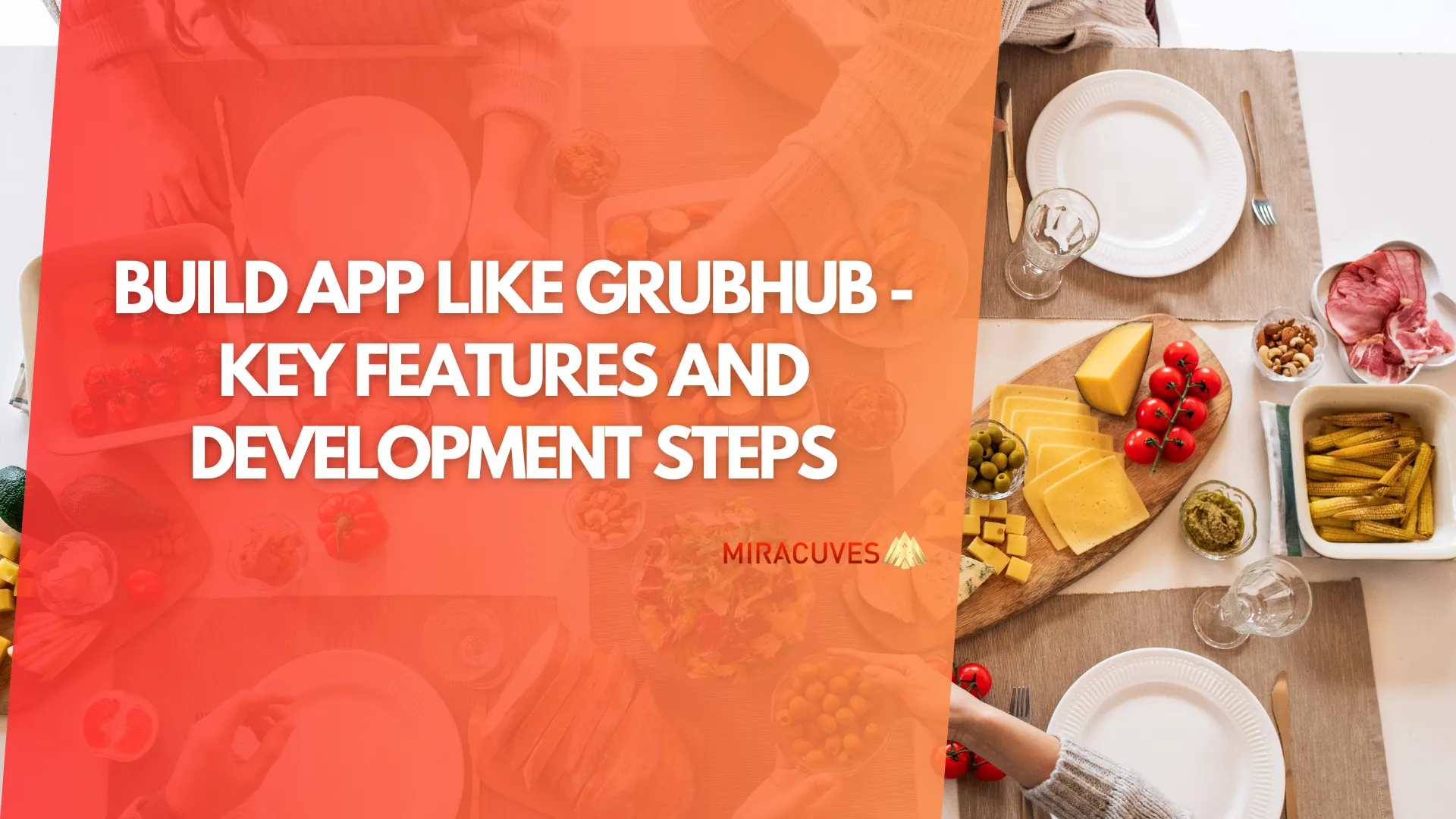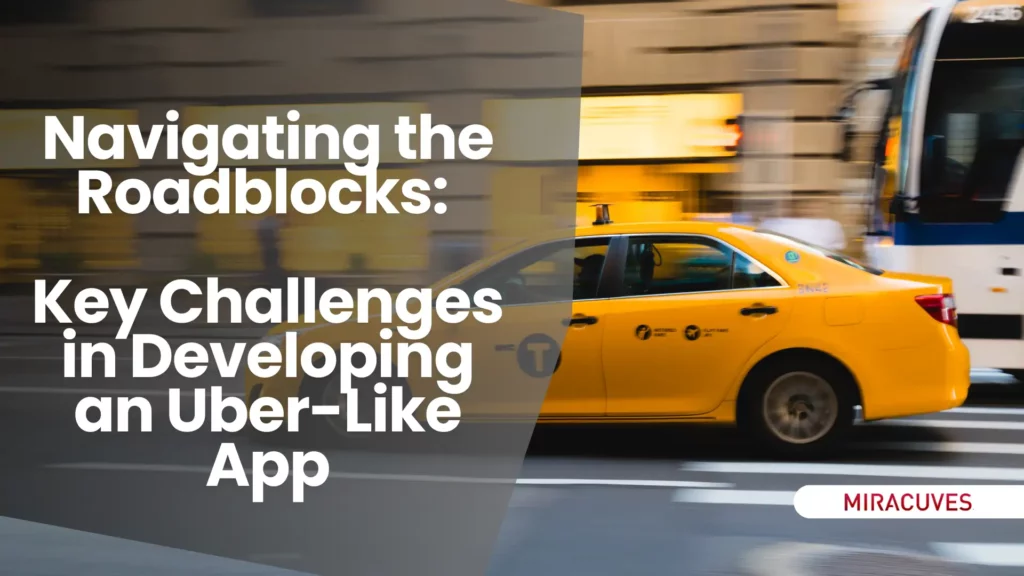In today’s fast-paced digital world, Food Delivery App Development platforms have become a lifeline for both restaurants and customers. Apps like Grubhub have revolutionized how people order food, offering convenience, variety, and speed. With the success of food delivery giants like Grubhub, entrepreneurs are increasingly seeking opportunities to build similar platforms that cater to this growing demand. But creating a Grubhub clone is no easy feat—it requires careful planning, the right technology stack, and an understanding of what makes these platforms thrive in a competitive market.
Miracuves Solutions offers a powerful, cost-effective approach for entrepreneurs looking to create a food delivery app like Grubhub. With pre-built, customizable templates, businesses can now develop feature-rich platforms quickly and at a fraction of the global development cost. This comprehensive guide will walk you through the essential features, development steps, and strategies for building a successful Grubhub clone. Whether you’re a startup founder or an established business aiming to expand your services, this guide will equip you with the knowledge needed to create your own restaurant delivery app.
Also Read :- How to Build a Food Delivery App Like Baemin
What is a Grubhub Clone and What Does It Do?
A Grubhub clone is a food delivery platform that replicates the core functionalities of Grubhub, allowing users to order food online from local restaurants and have it delivered to their doorstep. These platforms serve as a bridge between restaurants, delivery drivers, and customers, streamlining the entire food ordering and delivery process. A well-built Grubhub clone allows restaurants to list their menus, set delivery times, and manage orders, while customers can browse restaurants, place orders, and track their delivery in real-time.
The key purpose of a Grubhub clone is to offer a seamless and efficient online food ordering system, catering to the increasing demand for convenience. With the rising popularity of on-demand food services, apps like these provide a lucrative business model for entrepreneurs. The platform benefits not only customers but also restaurants by increasing their visibility and revenue, and drivers by offering job opportunities through the delivery driver app integration.
By using a pre-built solution like those offered by Miracuves Solutions, entrepreneurs can save time and cost while gaining access to features like GPS tracking, payment gateways, and customer reviews—all crucial for building a successful restaurant delivery app.
Why Build a Grubhub Clone?
Building a Grubhub clone offers a significant business opportunity, especially in today’s food delivery market, which continues to expand rapidly. The demand for on-demand food services has skyrocketed, driven by the convenience of ordering food online. Customers now expect their favorite restaurants to offer delivery services through easy-to-use mobile apps, and this trend shows no signs of slowing down. For entrepreneurs, creating a food delivery platform presents a profitable chance to tap into a multi-billion-dollar industry.
By developing a Grubhub clone, you can cater to a wide audience—customers, restaurants, and delivery drivers—offering each group a seamless and beneficial experience. Customers gain convenience, restaurants increase sales without the need to build their own infrastructure, and drivers find a flexible source of income. Additionally, launching a Grubhub clone allows you to compete directly with established players while offering your own unique spin, such as exclusive partnerships with local restaurants or faster delivery times.
One of the biggest challenges in developing such a platform is the cost and complexity of building it from scratch. This is where Miracuves Solutions comes in. With ready-made templates, you can cut the development time and cost significantly while still delivering a high-quality product. Instead of the typical global price of $6000 or more for custom development, Miracuves offers the same for just 10% of that cost, providing everything you need to launch quickly.
Also Read :- Top-10 Ideas for Food Delivery Business Startups
Market Size, Growth, and Revenue Model
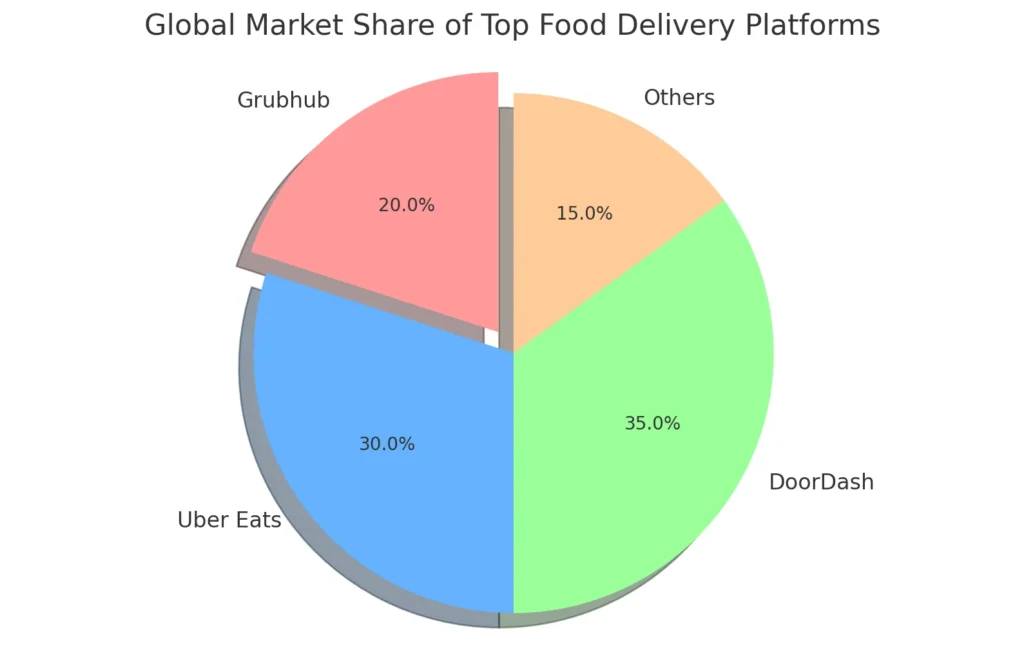
The online food delivery market has seen explosive growth in recent years, driven by the increasing demand for convenience and the widespread adoption of smartphones. According to recent reports, the global online food delivery market is projected to reach over $320 billion by 2029, with a compound annual growth rate (CAGR) of 10%. This surge in popularity provides a lucrative opportunity for entrepreneurs looking to build a Grubhub clone or similar food delivery platforms.
This market growth is fueled by several factors: the rising number of online users, the expanding digital infrastructure, and the growing trend of eating out being replaced by ordering in. As more restaurants partner with food delivery platforms, customers gain access to a wider variety of cuisines, further boosting the demand for such apps.
In terms of revenue models, there are several ways to monetize a Grubhub clone:
- Delivery Fees: Charging customers a fixed or dynamic fee for delivering food.
- Commissions: Taking a percentage of the order total from restaurants in exchange for providing delivery services.
- Subscription Models: Offering customers a premium subscription for free deliveries or other benefits.
- Restaurant Advertising: Charging restaurants for higher visibility or featured spots on the app.
- In-App Ads: Displaying ads from other businesses to generate additional revenue.
By tapping into these revenue streams, a Grubhub clone can quickly become profitable, particularly as the demand for restaurant delivery apps continues to grow.
How to Differentiate Your Grubhub Clone in the Market
Building a successful Grubhub clone means not just copying the core functionality, but also finding ways to stand out in a highly competitive market. While platforms like Grubhub, Uber Eats, and DoorDash dominate the space, there is still plenty of room for new players—especially those that offer unique value propositions to both customers and restaurants.
Here are several ways you can differentiate your food delivery platform from the competition:
- Local Partnerships: Focus on building partnerships with local restaurants that are not currently listed on the major platforms. Offering exclusive deals or working with niche eateries that provide unique cuisines can help you carve out a distinct space in the market.
- Faster Delivery: By optimizing the logistics behind delivery, you can offer faster delivery times than competitors, creating a better experience for users. Incorporating technologies like real-time GPS tracking and AI-based route optimization can make a significant difference.
- Loyalty Programs: Build customer loyalty by introducing reward programs that give customers points for each order, which can be redeemed for discounts or free deliveries. A strong loyalty program can increase customer retention.
- Green Initiatives: Set your app apart by focusing on environmentally friendly practices, such as offering customers the option to choose eco-friendly packaging or working with local couriers using electric vehicles or bicycles.
- Enhanced User Experience (UX): Simplify the ordering process with an intuitive app design and easy-to-navigate interfaces. Prioritize features like quick reordering, personalized recommendations, and real-time customer support.
By implementing these differentiators, your Grubhub clone can attract a loyal customer base and stand out among competitors.
Key Features of a Grubhub Clone
To create a successful Grubhub clone, it’s crucial to integrate essential features that drive the user experience for both customers and restaurants. These key features not only ensure a seamless ordering and delivery process but also enhance user satisfaction and engagement. Below are the fundamental features that any food delivery platform should include:
- User-Friendly Interface: The platform should offer an intuitive design, allowing users to easily browse restaurant listings, select their meals, and place orders with minimal effort. A clean and simple interface improves customer satisfaction and increases the chances of repeat orders.
- Restaurant Listings and Menus: The app must display an extensive list of partnered restaurants along with detailed menus, including photos, pricing, and descriptions. Having a variety of cuisines and easy-to-access information is key to attracting users.
- Real-Time GPS Tracking: One of the most crucial features of a restaurant delivery app is real-time GPS tracking. This allows customers to track their orders from the moment the food is prepared to when it’s delivered to their door. It also helps drivers optimize their routes for faster deliveries.
- Multiple Payment Gateways: Offering a range of payment options such as credit cards, digital wallets (like PayPal or Google Pay), and even cash-on-delivery ensures convenience for all users. Integrating secure payment gateways builds trust with customers.
- Ratings and Reviews: Customers should be able to rate both the food and delivery service. This feature adds transparency, improves the app’s credibility, and helps new customers make informed decisions.
- Order History and Reordering: Make it easy for users to access their previous orders and reorder with a single tap. This enhances convenience and boosts the chances of repeat business.
- Delivery Driver App: An efficient delivery driver module is essential for ensuring that drivers can accept and manage orders, communicate with customers, and get real-time navigation. This helps streamline the delivery process.
By implementing these core features, your Grubhub clone will provide a complete solution for food ordering, from selecting a restaurant to receiving a meal at the customer’s door. Utilizing readymade solution can expedite the inclusion of these features, ensuring your app is competitive from the start.
Minimum Viable Product (MVP) for a Grubhub Clone
When building a Grubhub clone, it’s often smarter to start with a Minimum Viable Product (MVP). An MVP focuses on developing the core features of your app with just enough functionality to attract early users and gather feedback. This approach helps you test your concept in the market without spending unnecessary time and resources on features that may not be essential in the early stages.
By launching with an MVP, you can quickly gauge customer interest, make data-driven decisions, and improve your app based on real user feedback. This reduces the risk of failure and allows you to scale your platform in the right direction. For a food delivery platform, here are the key features that should be part of your MVP:
- Basic User Interface (UI): A simple, user-friendly interface that allows customers to browse restaurants, view menus, and place orders easily.
- Restaurant Listings and Menus: Include a curated list of local restaurants with basic menu options, ensuring customers have choices even in the MVP stage.
- Order Management: Customers should be able to place and track orders, while restaurants and delivery drivers should have the tools to manage orders efficiently.
- Real-Time GPS Tracking: This is a non-negotiable feature in a food delivery app, even in an MVP. Customers expect to track their orders in real-time, from preparation to delivery.
- Secure Payment Gateway: Include one or two popular payment options, like credit cards or digital wallets, to allow customers to complete transactions securely.
The beauty of an MVP is that you can start small and add features over time as your user base grows. As you gather feedback, you can introduce additional features like loyalty programs, restaurant reviews, and more. By using readymade solution from providers like Miracuves Solutions, you can launch your MVP faster, with all the essential features in place, at a fraction of the cost.
Technical Requirements for Building a Grubhub Clone
| Component | Custom-Built | Pre-Built Template |
|---|---|---|
| Frontend | React Native / Flutter | Already Integrated (Ready to deploy) |
| Backend | Node.js / Django | Already Integrated (Ready to deploy) |
| Database | MongoDB / MySQL | Already Integrated (Ready to deploy) |
| APIs | Google Maps API / Stripe / PayPal | Already Integrated (Ready to deploy) |
| Cloud Hosting | AWS / Google Cloud | Already Integrated (Ready to deploy) |
Building a Grubhub clone requires selecting the right technology stack to ensure your app is fast, scalable, and secure. A strong technical foundation is essential for handling thousands of restaurant listings, real-time order tracking, and secure payments. Whether you are developing your app from scratch or using pre-built templates, understanding the technical requirements will help you make informed decisions.
Here are the key technical components needed to build a food delivery platform like Grubhub:
- Frontend Technologies: The frontend is what users interact with, so it needs to be responsive, fast, and easy to use. Popular frontend technologies for food delivery apps include React Native and Flutter, which allow you to build cross-platform mobile apps (iOS and Android) using a single codebase. This reduces development time and ensures a consistent user experience across devices.
- Backend Technologies: The backend handles all the server-side operations like order management, user authentication, and payment processing. Node.js or Django (Python) are commonly used for backend development due to their scalability and speed. These technologies can handle large volumes of real-time transactions and data processing, ensuring smooth performance even during peak times.
- Database: To store user data, restaurant details, and order history, you need a reliable and scalable database. MongoDB or MySQL are popular choices, offering flexibility in handling large datasets and ensuring quick access to stored information.
- APIs and Integrations: To provide real-time GPS tracking, payment processing, and restaurant management, your app will need to integrate with external APIs. For GPS tracking, tools like Google Maps API or Mapbox are essential. For payments, services like Stripe, PayPal, or Braintree ensure secure transactions.
- Cloud Hosting: Your app will need reliable hosting to manage server requests and handle large amounts of data. Amazon Web Services (AWS) or Google Cloud offer scalable cloud hosting solutions that can grow as your app’s user base increases.
By leveraging the right technology stack, you can ensure your Grubhub clone operates efficiently and provides a seamless experience to users, restaurants, and delivery drivers. Using pre-built solutions allows you to skip the heavy lifting on the backend setup, ensuring your app is built on a solid foundation while saving both time and cost.
To ensure secure transactions and a smooth payment experience, integrate a reliable payment gateway such as Stripe, which adheres to PCI compliance standards
Design and User Interface for Your Grubhub Clone
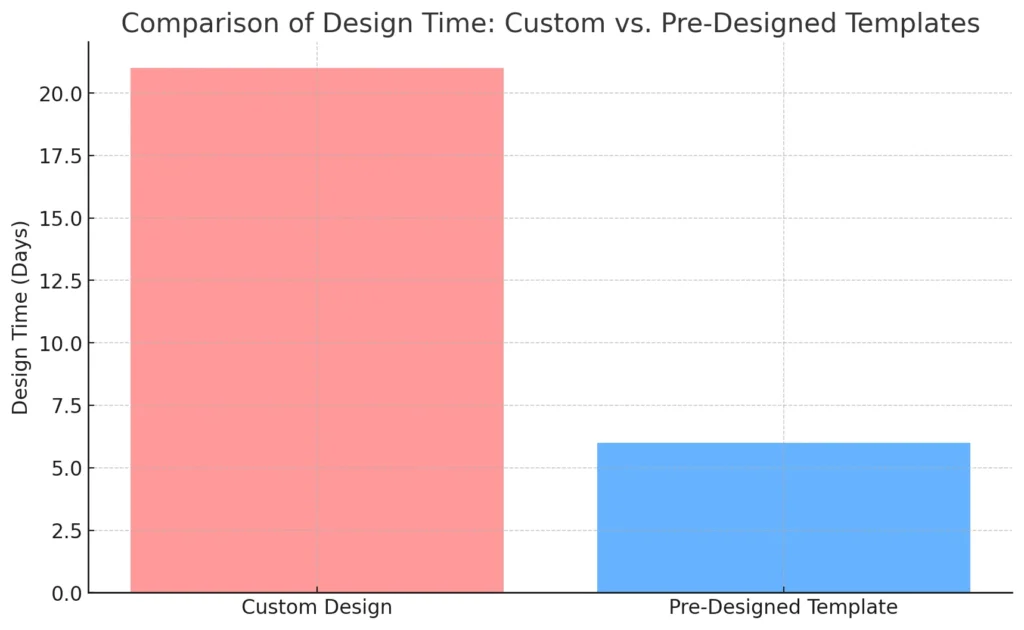
The design and user interface (UI) of a food delivery platform like a Grubhub clone is critical to its success. Customers expect a smooth, intuitive experience when ordering food online, and any friction in the user journey can result in lost orders and unsatisfied users. Therefore, focusing on a clean, user-friendly design is essential for retaining customers and keeping them engaged with your app.
A well-designed Grubhub clone should focus on the following key elements:
- Simple Navigation: The app’s design should allow users to browse restaurant listings, filter by cuisine, and place orders without hassle. Having a streamlined process for finding restaurants, adding items to the cart, and completing the checkout process is key.
- Responsive Design: Given that users will access the app from different devices (smartphones, tablets), the design should be fully responsive. This ensures a seamless experience across screen sizes and devices, whether it’s iOS, Android, or web-based.
- Clear Visual Hierarchy: Important elements such as menus, order buttons, and delivery tracking should be easily accessible. Highlighting these features with strategic placement and clear icons ensures that users can navigate the app with ease.
- Personalization: Personalizing the user experience, such as displaying favorite restaurants, saved orders, or customized meal recommendations, can significantly enhance customer satisfaction. The design should cater to these personalized features without overwhelming the user.
- Branding and Aesthetics: Your app’s branding should be consistent across all screens, incorporating your unique color palette, logo, and style. Consistent branding creates trust and helps your app stand out in the crowded market.
Using pre-designed templates can significantly reduce the time and cost associated with developing a sleek, user-friendly interface. These templates are already optimized for modern UI/UX standards, which means you can launch your app with confidence, knowing the design is already tested and user-approved.
Want to create a seamless food delivery experience like Grubhub?
Let us help you build a high-performance app with real-time
tracking, secure payments, and customer-friendly features.
Development Process for a Grubhub Clone
| Stage | Custom Development | Readymade Solutions |
|---|---|---|
| Planning | 1-2 weeks | 3-4 days |
| Design | 3-4 weeks | 5-7 days |
| Frontend & Backend Development | 4-6 weeks | 7-10 days |
| API Integration | 2-3 weeks | Already Integrated |
| Testing | 1-2 weeks | 2-3 days |
| Deployment | 1 week | 1-2 days |
Building a Grubhub clone involves a well-organized development process, ensuring that your app functions smoothly and is delivered on time. Whether you choose to develop the platform from scratch or use readymade solutions, following a structured development path is key to success. Below are the critical stages involved in the development of a food delivery app like Grubhub.
1. Planning and Research
Before diving into development, thorough planning is essential. This stage involves defining the app’s core features, understanding your target audience, and performing market research. Creating user personas helps identify customer pain points and how your app will address them.
2. Wireframing and Prototyping
The next step is creating wireframes and prototypes that map out the user journey. Wireframes are simple layouts that give you an idea of how each screen of the app will look, while prototypes are more interactive and allow you to test user flows before actual development begins. This ensures that the design and user experience are aligned with your vision.
3. Frontend and Backend Development
The development phase begins by building both the frontend (user interface) and backend (server-side logic). The frontend development focuses on creating a responsive, intuitive interface where users can browse restaurants, place orders, and track deliveries. The backend handles data processing, order management, and communication between restaurants, delivery drivers, and customers.
- Frontend: Use technologies like React Native or Flutter for building cross-platform apps, ensuring a consistent experience on both iOS and Android devices.
- Backend: Use scalable backend technologies such as Node.js or Django to handle large volumes of data, ensuring smooth performance even during high traffic.
4. Integration of APIs
To provide essential features like real-time GPS tracking, secure payment processing, and order management, you will need to integrate third-party APIs. These integrations allow your app to communicate with external services for mapping, payment gateways, and notifications.
5. Testing and Quality Assurance (QA)
Once the app is built, rigorous testing is conducted to ensure there are no bugs or glitches. This involves testing various features such as order placement, payment processing, and delivery tracking on multiple devices to ensure a seamless user experience. Functional, usability, and performance testing are crucial to iron out any issues before the app goes live.
6. Deployment
After successful testing, the app is ready for deployment. This involves submitting the app to platforms like the App Store (for iOS users) and Google Play Store (for Android users). Ensuring that your app meets all platform guidelines is essential for approval.
Using readymade solutions from providers like Miracuves Solutions can significantly speed up the development process. These templates come with ready-to-deploy features, saving you both time and money, and allowing your app to hit the market faster than traditional custom development.
Cost Estimation and Timeframe for Building a Grubhub Clone
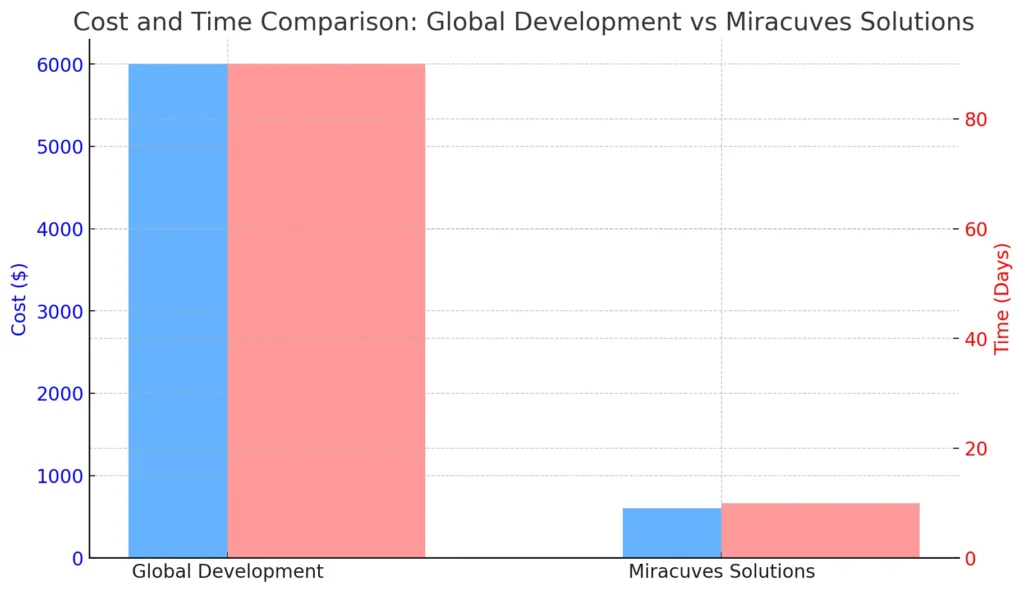
The cost and timeframe for developing a Grubhub clone can vary greatly depending on the method you choose—custom development or using readymade solutions. Understanding the financial and time commitments involved is essential for planning a successful app launch. Let’s break down both the cost and timeframe for each approach.
Custom Development Costs
Developing a Grubhub clone from scratch requires a team of designers, developers, project managers, and testers. The cost depends on the complexity of the app, the number of features, and the hourly rates of developers, which vary by region.
On average, the global cost for custom app development can be $6,000 to $15,000 for a basic version, with complex features like real-time GPS tracking, multiple payment gateways, and driver management increasing the price even further. This figure includes:
- Planning and Research: $1,000
- Design and Prototyping: $1,500
- Development (Frontend & Backend): $5,000
- API Integration: $2,000
- Testing and QA: $1,000
- Deployment and Maintenance: $500-$1,000
Custom development also comes with a longer timeline, usually taking 2-3 months to complete a fully functional app.
Miracuves Solutions Costs
In contrast, using Miracuves Solutions’ pre-built templates can dramatically reduce both the cost and the development time. Miracuves offers ready-to-use app solution that come with all the essential features pre-integrated, such as real-time tracking, payment gateways, and order management. This allows you to launch your app much faster while keeping costs low.
With Miracuves Solutions, the cost is typically 10% of the global price, which means you can build your app for $600 instead of $6,000. The development timeframe is also shortened to just 10 days, compared to the months required for custom development.
This cost-saving approach is ideal for entrepreneurs and small businesses looking to enter the food delivery market quickly and efficiently.
Why Trust Miracuves Solutions for Your Next Food Delivery App?
When building a Grubhub clone, choosing the right development approach is critical. While custom development can offer full control over every feature, it also comes with high costs, long timelines, and complexities. On the other hand, readymade solutions, like those offered by Miracuves Solutions, provide an affordable, efficient, and reliable way to launch a food delivery app quickly, without sacrificing quality.
Here’s why you can trust readymade solutions for your next project:
1. Cost-Effectiveness
Pre-built templates offer significant cost savings. As mentioned earlier, developing a food delivery app from scratch can cost upwards of $6,000, but with Miracuves Solutions, you can reduce that cost by 90%, paying only $600 for a fully functional, feature-rich platform. These templates come with everything you need, including restaurant listings, GPS tracking, and payment gateways, without the hefty price tag of custom development.
2. Faster Time to Market
In a competitive market, time is crucial. Custom-built apps can take 2-3 months to develop, which may result in missed opportunities. With readymade solutions, the entire process—design, development, testing, and deployment—can be completed in as little as 10 days. This allows you to launch your app quickly, capitalize on market demand, and start generating revenue sooner.
3. Proven and Tested Framework
readymade solutions from established providers like Miracuves Solutions are built on a proven and tested framework. These templates are used by multiple businesses and are optimized for performance, scalability, and user experience. You’re not taking risks with untested code—instead, you’re leveraging a stable foundation that has been successfully deployed across various projects.
4. Customizable for Your Brand
While pre-designed solutions save time and money, they also offer plenty of room for customization. You can tailor the design, features, and branding to suit your specific business needs. Whether it’s the look and feel of the app or adding unique features like loyalty programs or exclusive restaurant partnerships, Miracuves’ readymade solutions provide flexibility for personalization.
5. Ongoing Support and Updates
With readymade solutions, you get more than just the initial setup. Providers like Miracuves Solutions offer ongoing support, ensuring that your app remains up-to-date with the latest technologies, security patches, and market trends. This gives you peace of mind, knowing that your platform will continue to evolve and perform well even as your business grows.
By trusting readymade solutions, you can enter the highly competitive food delivery market with confidence. You get the benefit of speed, cost savings, and reliability, while still having the flexibility to create a unique offering.
Monetization Strategies for a Grubhub Clone
| Monetization Strategy | App Benefit | Restaurant Benefit |
|---|---|---|
| Delivery Fees | Steady income per order | Customers pay for delivery convenience |
| Restaurant Commissions | Percentage of restaurant sales | Exposure to new customers via the app |
| Subscription Plans | Recurring revenue | Increased customer loyalty |
| In-App Ads | Ad revenue from businesses/restaurants | Targeted advertising opportunities |
| Featured Listings | Paid visibility in search results | Higher visibility and more orders |
Building a Grubhub clone isn’t just about creating an app that functions well—it’s also about making it profitable. There are several tried-and-tested ways to monetize a food delivery app, and incorporating these strategies can help you generate steady revenue while providing value to both customers and restaurants.
Here are the top monetization strategies you can implement in your Grubhub clone:
1. Delivery Fees
One of the most common ways to generate revenue is by charging customers a delivery fee. This can either be a flat rate or a dynamic fee based on factors like distance, order size, or time of delivery (e.g., peak hours). Many platforms also offer the option of free delivery for users who subscribe to premium services.
2. Restaurant Commissions
Charging a commission on each order placed through your platform is another major revenue stream. Grubhub and similar platforms typically charge restaurants a percentage of each sale, which can range from 10-30% depending on the agreement. This model ensures that you earn revenue every time a customer orders from a restaurant via your app.
3. Subscription Plans
Offering a subscription service where customers pay a monthly or yearly fee for perks like free delivery, exclusive discounts, or priority support is an excellent way to create consistent revenue. Grubhub’s Grubhub+ subscription model is an example of how premium users get more value, while you benefit from recurring payments.
4. In-App Advertising
Monetizing your app through in-app ads is another potential revenue stream. You can partner with local businesses, brands, or even restaurants that want to advertise their deals, new menu items, or promotions to users. This can be implemented via banner ads, pop-ups, or sponsored listings within the app.
5. Featured Listings and Promotions
Another strategy is to charge restaurants for featured listings or promotions. Restaurants pay to have their business listed at the top of the search results or highlighted in specific categories, giving them more visibility. This is especially beneficial for new or smaller restaurants looking to attract more orders.
6. Premium Placement Fees
You can also offer premium placement on the homepage or during peak dining hours, where restaurants pay extra to be seen first by users. These premium placements can attract more orders for the restaurants and generate additional revenue for your platform.
By implementing a combination of these monetization strategies, you can ensure that your Grubhub clone not only thrives in the market but also generates substantial income over time. Combining subscription models, delivery fees, and restaurant commissions will create a diversified revenue stream that provides long-term sustainability for your business.
Launching and Marketing Your Grubhub Clone
Building a Grubhub clone is only the first step; the real challenge lies in successfully launching and marketing your app to attract users. In a competitive market, a solid launch strategy combined with effective marketing techniques can make the difference between success and failure. Below are some essential steps to help you launch and market your food delivery platform effectively:
1. Pre-Launch Buzz
Before launching, start generating buzz about your app. Use social media marketing and influencer partnerships to create awareness and excitement. Consider creating teaser campaigns that show off the app’s features or offer exclusive deals for early sign-ups. A strong pre-launch campaign can build anticipation and ensure that you have an eager user base ready on day one.
2. App Store Optimization (ASO)
When you launch your app on platforms like the Apple App Store or Google Play Store, make sure it’s optimized to appear in search results. This is where App Store Optimization (ASO) comes in. Focus on using relevant keywords such as “food delivery app,” “restaurant delivery,” or “Grubhub alternative” in your app description and title. Additionally, use high-quality screenshots, a compelling app icon, and engaging promotional videos to attract users.
3. Referral and Loyalty Programs
To quickly grow your user base, offer referral programs where existing users can invite others in exchange for rewards like free delivery or discounts. Loyalty programs that reward customers for frequent usage can also boost retention, encouraging them to return to your app for future orders.
4. Social Media and Local Marketing
Utilize social media platforms like Instagram, Facebook, and Twitter to engage with potential users. Create engaging posts that showcase popular restaurants on your platform, highlight user experiences, and share promotions. Additionally, focus on local marketing by partnering with restaurants for exclusive deals or promotions. Sponsor local food events or work with local influencers to promote your app and create a community around it.
5. Paid Advertising Campaigns
Running paid ads on platforms like Google, Facebook, and Instagram can help drive initial traffic to your app. Use targeted ads to reach food lovers and local communities, ensuring your marketing dollars are spent wisely. Paid search ads with keywords like “best food delivery app” can capture users searching for services similar to Grubhub.
6. Engage with Local Restaurants
One of the best ways to market your Grubhub clone is by partnering with local restaurants. Offer them promotional opportunities on your platform and work with them to provide exclusive deals that can attract new users. A mutually beneficial partnership with restaurants can lead to increased visibility for your app and more orders for the restaurant.
By implementing these strategies, you’ll be able to launch your app successfully and create an initial user base. Once your app is live, continuous marketing efforts like social media engagement, paid campaigns, and loyalty programs will keep your users engaged and drive growth.
Also Read :- Building Food Delivery Platform Like Amazon Fresh
Legal and Regulatory Considerations
Launching a Grubhub clone involves more than just building and marketing the app. You must also navigate various legal and regulatory considerations to ensure that your platform operates within the law and avoids potential liabilities. The food delivery industry deals with sensitive areas such as food safety, payment processing, and customer data protection, making compliance a top priority.
Here are the key legal and regulatory factors to keep in mind when developing your food delivery platform:
1. Licensing and Permits
Before launching, make sure you have the necessary licenses and permits to operate a food delivery service. Regulations may vary depending on your location, but common licenses include business licenses, food delivery permits, and partnership agreements with restaurants. It’s crucial to consult with a legal expert to understand the local laws governing food delivery platforms in your target region.
2. Food Safety Regulations
As a food delivery platform, you need to ensure that your partnered restaurants comply with all food safety regulations. This involves verifying that restaurants hold proper food handling licenses and are inspected regularly by health authorities. Including a clause in your partnership agreements that requires restaurants to meet these standards will help protect your business from legal issues related to food quality or contamination.
3. Data Protection and Privacy Laws
Your app will collect sensitive information from users, including personal details, payment information, and order history. It’s essential to comply with data protection laws such as the General Data Protection Regulation (GDPR) in Europe or the California Consumer Privacy Act (CCPA) in the United States. Make sure your app includes clear privacy policies that inform users about how their data is collected, used, and stored. Additionally, integrate secure encryption technologies to protect user data from breaches.
4. Payment Processing Compliance
Handling payments through your app involves complying with payment processing laws. Ensure that the payment gateways you integrate, such as Stripe or PayPal, adhere to industry standards for secure transactions. PCI DSS (Payment Card Industry Data Security Standard) compliance is a must for protecting sensitive financial data and preventing fraud.
5. Employment Laws for Delivery Drivers
If your platform employs or contracts delivery drivers, it’s important to comply with local employment laws. This includes understanding whether your drivers are classified as employees or independent contractors, which will impact their rights and your responsibilities regarding wages, benefits, and working conditions. Be sure to have clear terms in your driver agreements regarding hours, wages, and expectations.
6. Marketing and Advertising Laws
When promoting your Grubhub clone, you must also ensure compliance with advertising laws. Avoid making false claims or promises that cannot be delivered. Additionally, any promotions, discounts, or contests should comply with local laws regarding advertising and consumer protection.
By understanding and addressing these legal and regulatory requirements, you can ensure a smoother launch for your food delivery platform and avoid potential legal pitfalls.
Future Growth and Scalability of Your Grubhub Clone

Building a Grubhub clone is not just about launching an app; it’s about creating a platform that can scale and grow as your business expands. Scalability is key to handling increased traffic, expanding into new markets, and continuously improving the user experience. As your app gains traction, you’ll need to ensure it’s designed to handle a larger user base and more orders without compromising performance.
Here are the key strategies for scaling and driving future growth for your food delivery platform:
1. Cloud Infrastructure for Scalability
To prepare for growth, it’s essential to use a cloud-based infrastructure like Amazon Web Services (AWS) or Google Cloud. Cloud solutions offer flexibility and scalability, allowing you to quickly increase server capacity during peak demand or as your user base grows. This prevents crashes, slow loading times, and ensures that your app continues to perform smoothly as your business scales.
2. Adding New Features
As your platform expands, you can differentiate your app by adding new features that meet user demands. For example, after launching your MVP, you could introduce features like loyalty programs, in-app chat support, or AI-based meal recommendations to enhance the user experience. Continuously improving and adding features helps keep your app competitive and engaging.
3. Geographic Expansion
Once your Grubhub clone gains traction in your local market, the next logical step is to expand into new regions. Expanding your delivery zones and partnering with more restaurants across different cities or states can significantly increase your revenue. Before expansion, ensure that your app is capable of handling multi-location logistics and that you have the necessary delivery network to support the growth.
4. Integrating Advanced Analytics
To make informed decisions as your platform grows, you’ll need to integrate advanced analytics. Analytics can provide insights into customer behavior, delivery times, peak order periods, and restaurant performance. With these insights, you can optimize delivery routes, create targeted marketing campaigns, and improve overall user satisfaction.
5. Marketing for Long-Term Growth
Scaling also involves consistently attracting new users and keeping existing ones engaged. Invest in long-term marketing strategies like content marketing, SEO, and social media campaigns to maintain visibility and drive user acquisition. As your business grows, you can explore partnerships with larger brands or even offer white-label solutions to other businesses looking to enter the food delivery space.
6. Optimizing for Efficiency
With growth comes the need for operational efficiency. Use automated order management systems, route optimization tools, and AI-powered customer support to handle increased demand without overwhelming your staff. Automation helps streamline processes, reduce delivery times, and provide consistent service even as order volumes grow.
By focusing on scalability from the start, your Grubhub clone will be well-equipped to handle future growth, ensuring that it remains competitive in an evolving market. With the right infrastructure, feature set, and marketing strategies, your app can not only survive but thrive as a major player in the food delivery industry.
Using a cloud-based infrastructure like AWS ensures that your app is scalable and capable of handling high traffic during peak demand.
Conclusion
Building a Grubhub clone presents a significant opportunity in the growing food delivery industry. As more consumers turn to online platforms for convenience, launching a feature-rich, scalable, and user-friendly app is crucial for success. From understanding the key features like restaurant listings, real-time tracking, and multiple payment gateways to leveraging the right technology stack, the journey of developing your app can be made simpler and more affordable with solutions like those offered by Miracuves Solutions.
By opting for readymade solution, you can drastically cut down on both cost and development time, allowing you to enter the market faster and compete with industry giants. Additionally, planning for future scalability, exploring monetization strategies, and adhering to legal regulations will ensure that your platform is not only functional but also sustainable in the long run.
Whether you’re a startup entrepreneur or an established business looking to expand into food delivery, a Grubhub clone built on a solid foundation with the right features can help you carve out your own space in this booming industry. With careful planning, the right tools, and ongoing improvements, your app can thrive and grow, delivering value to customers, restaurants, and delivery drivers alike.
From restaurant listings to real-time order tracking !
Our food delivery app solution has everything you need.
FAQs
What is the cost to build a Grubhub clone?
The cost of building a Grubhub clone can vary depending on whether you choose custom development or pre-built solutions. Custom development can cost between $6,000 and $15,000, while pre-built solutions from providers like Miracuves Solutions cost as little as $600.
How long does it take to launch a Grubhub clone using templates?
With pre-built templates, you can launch your app in as little as 10 days, compared to the 2-3 months it takes for custom development.
Can I customize the Grubhub clone to fit my brand?
Yes, readymade solution offer extensive customization options. You can modify the design, features, and branding to align with your specific business needs.
What features are included in a pre-built Grubhub clone?
Pre-built Grubhub clones come with all essential features, including restaurant listings, real-time GPS tracking, multiple payment gateways, delivery driver management, and order history.
Is it legal to create a Grubhub clone?
Yes, it is legal to create a food delivery app similar to Grubhub. However, ensure your app complies with local licensing, data protection laws, and food safety regulations.



